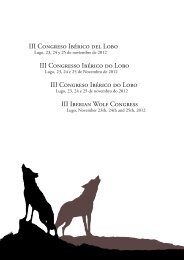Bison-Rewilding-Plan-2014
Bison-Rewilding-Plan-2014
Bison-Rewilding-Plan-2014
- No tags were found...
You also want an ePaper? Increase the reach of your titles
YUMPU automatically turns print PDFs into web optimized ePapers that Google loves.
use of young animals two to four years of agebecause of their easier availability, greater ease inhandling and managing them and their ability toadapt to the local circumstances. It is also easierto introduce younger animals to the releasesite. Several adult animals (females) will be keptwith the younger individuals for ‘social stability’and to teach them survival skills. Individualbehaviour will be monitored and based on this itwill be decided if the founder adult animals willbe released with the young animals, which willby that time have reached an adult age and will be‘experienced’ and have formed a good social bond.The male to female ratio of the founder group willdepend on the availability of animals, but will notexceed 50% in favour of males. A ratio in favour ofmore females is preferred as it results in a greaterrate of population increase. Although an evengender ratio is closest to that of wild populations,it can often be slightly in favour of females dueto higher mortality among males. If the ratio isuneven in favour of males, this risks small groupssplitting off and migrating for large distances,which would make monitoring and managementmore complex.The preferred (minimum) composition of thefounder group is therefore three young males(under four years old) and six females, of whicha minimum of two are adults that can take on aleading role and add stability and experience tothe group.The mixed group will first be released in theacclimatisation zone at the same time or with aminimum as possible time (< 10 days) in betweeneach release. Due to the large size it is possible touse the semi-wild release areas (rewilding zone) inmixed-species settings, to combine with reintroductionof other large herbivores, e.g. red deer, asthere is adequate space for animals to voluntarilyseparate themselves when desired or necessary.However, extra hayfeeders need to be provided toavoid competition for food.In the wild, bison are both gregarious andnon-territorial. Male reproductive success isbased on dominance over other males rather thandominance at a particular site. Therefore adultand sub-adult bulls should not be placed in theacclimatisation zone as adult bulls may drive outor attack young males when they begin to exhibitsecondary sexual characteristics.2.1Further additions to the founder groupDuring the reintroduction project new groups willbe added to the founder group. This founder groupwill gradually establish and form bonds. New herdmembers should, preferably, be given a period oftime, generally several weeks, that allows them togradually familiarise themselves with the existinggroup before progressing to full physical contact.Animals can be separated between the acclimatisationzone and semi-wild reserve, with the‘newcomers’ in the former and the ‘old-timers’ inthe latter area. New Animals should never be addedto the group in the acclimatisation zone. With theabove exception if there is maximum 10 days inbetween when the social hierarchy has not beenestablished yet between the members of the firstgroup.Several years after the first releases, when youngbulls have reached adulthood, adult males can alsobe added to the herd to further broaden the genepool. <strong>Rewilding</strong> Europe wants to avoid furtherculling of bison and therefore males, young andold, will be accepted for re-introduction, if adequatefunding can be found for their transportation.It is estimated that roughly ten animals per yearwill be available for each bison reintroduction area.With an annual re-stock of ten animals and anexpected annual growth of 20% (based on severalassumptions, age of founder animals, annualdeaths etc.) this should result in a population ofover 175 animals after ten years over a minimum offive sites. This is the minimum population growththat <strong>Rewilding</strong> Europe is striving for. Additionalstocking could also be increased if more animalsbecome available, there are sufficient financialresources, the initial population is healthy andthere is continued local support. This would inturn further increase the annual populationgrowth rate.52



